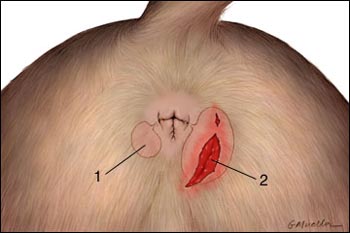Anal sacs are the reservoirs for the secretions of anal glands which are located on either side of a dog's anus, at approximately four and eight o'clock. These sacs contain liquid secretions from the anal gland, which, in healthy animals, are normally pale yellow-brown to grayish in color. The contents are usually emptied during normal bowel movements, or when a dog is nervous or scared. In most animals, these sacs empty easily. However, some dogs, especially small breed dogs, are not able to empty the sacs properly and become susceptible to anal sac disease.
A dog with anal sac disease may scoot across the ground in an attempt to relieve the sensation of pressure and irritation around its rectum. Dogs with this illness will also chase their tails and bite or lick their rear ends to alleviate the discomfort.

- Normal anal sac
- Inflamed and ruptured anal sac
There are three progressive stages of anal sac disease. The three stages include anal sac impaction, anal sacculitis, and anal sac abscess. Anal sac impaction occurs when the liquid accumulates and thickens, causing the anal sacs to become distended and difficult to empty. A veterinarian can usually relieve the impaction by rectally squeezing the grape-like sacs individually until the thickened substance is expressed.
The second stage of the disease is known as anal sacculitis, or inflammation of the anal sac. In this stage the anal sac material continues to accumulate and may become infected by bacteria. The third, and final, stage is abscess formation. This stage is the most severe and the most painful of the anal sac diseases. It may require surgical treatment. Sometimes the abscess can rupture through the skin, leaving an oozing red hole that is visible next to the anus. All stages of anal sac disease are treatable by a veterinarian.





































